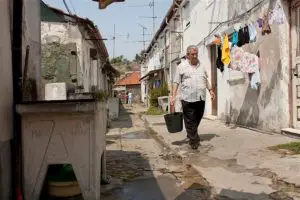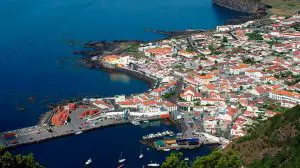Chance of poverty is higher in the Azores
Risk was 29.6% while mainland Portugal was 19.4%

Correio dos Açores reports that as seen in the three core indicators – poverty, very low per capita work intensity and material and social deprivation – the risk of poverty or social exclusion in 2022 has decreased in all regions of the continent, but has not only increased but remains higher in regions autonomous regions of the Azores (29.6%) and Madeira (29.6%), announced yesterday the National Statistics Institute.
Risk of poverty is the condition of the resident population whose equivalent disposable income is below the poverty line. Thus, almost 30 Azoreans out of 100 are below the poverty line, which is the most fragile relationship in Portugal alongside Madeira.
Adverse housing conditions have decreased on the mainland but increased last year in the Azores. The results of the Survey on Living Conditions and Income also indicate that 9.2% of people lived in accommodation in 2022 in which the number of habitable rooms (≥ 4 square meters) was insufficient for the number and demographic profile of household members , 1.4 percentage points less than in the previous year. Housing overcrowding mainly affected residents in the Algarve region (13.5% of residents), the Azores (13.5%) and Madeira (13%).
Living in overcrowded accommodation was, in 2022, a condition that mainly affected families at risk of poverty (19.2%) and families residing in densely populated areas (10.8%). For the same year, the housing overcrowding rate was higher for younger people (15.6% for the age group up to 17 years), decreasing with increasing age (9.9% for adults and 3 % for the elderly).
The at-risk-of-poverty rate had already increased by 3.2 percentage points in the Azores between 2020 and 2021, rising to 25.1% in the Region, surpassed only by Madeira, where the at-risk-of-poverty rate is 25.9%.
In 2021, considering the national poverty line, the risk of poverty decreased in the North, Centre, Área Metropolitana de Lisboa and Alentejo regions and increased in the Algarve region (plus 0.5 percentage points) and in the autonomous regions (plus 3.2 percentage points in the Azores and a further 1.7 percentage points in Madeira).
While the at-risk-of-poverty rate in the Lisbon Metropolitan Area was substantially lower than the national figure – 10.4%, that is, 6 percentage points less than the national at-risk-of-poverty rate -, the Algarve and the autonomous regions of the Azores and Madeira had at-risk-of-poverty rates of 22.1%, 25.1% and 25.9%, respectively, “well above the national figure”, indicates the National Institute of Statistics.
Less inequality in Portugal, more inequality in the Azores
The three main indicators of inequality have reduced at national level, “despite monetary income in Portugal continuing to be characterized by a strongly asymmetrical distribution”, says INE.
The Gini Coefficient, which takes into account the entire distribution of income, reflecting differences in income between all population groups, registered a value of 32%, 1 percentage point less than in the previous year (33%). The Gini Coefficient is the indicator of inequality in the income distribution that aims to synthesize in a single value the asymmetry of this distribution. It assumes values between 0 (when all individuals have the same income) and 100 (when all income is concentrated in a single individual).
And, according to the National Institute of Statistics, “it appears that the Autonomous Region of the Azores is the one with the greatest inequality (Gini coefficient): 34.8%, a value higher than the national average (32%).
In 2021, as in 2020, the Alentejo region had the least unequal income distribution (30.8%). Inequality decreased in the North, Center and Área Metropolitana de Lisboa regions, remained unchanged in the Alentejo region and increased in the Algarve region, the Azores and Madeira.
The per capita work intensity rate has decreased in Portugal
In addition to income, there are other conditions that can increase a family’s risk of social exclusion, namely the degree of participation of its members in the labor market.
To assess this risk, the Europe 2030 strategy uses the indicator relating to very low per capita work intensity: very low per capita work intensity is considered for all people under 65 who, in the income reference period, lived in households in which the adult population aged 18 to 64 reported having worked, on average, less than 20% of the possible working time (students aged 18 to 24 are excluded; retirees and/or old-age or disability pensioners ; and inactive people aged 60-64 and living in households whose main source of income are pensions).
In 2021, the proportion of the population aged under 65 living in households with very low per capita work intensity was 4.6% in 2021, a figure lower than that recorded in the previous year (5.2%).
However, the proportion of the non-elderly population living in households with very low per capita labor intensity decreased in almost all regions of the continent in 2021, but increased in the Algarve region and in the Azores and Madeira.
Madeira registered the highest value for this indicator (7.9%) as well as the biggest increase, 1.3 percentage points more than in the previous year (6.6%).
19.4% at risk of poverty in Portugal and 29.6% in the Azores
The European Union’s economic growth strategy for the next decade, known as the Europe 2030 strategy, defines, among other objectives, the reduction of the number of people at risk of poverty or social exclusion in the European Union by at least 15 million people by 2030, including at least 5 million children.
The same strategy defines a new indicator for monitoring the population at risk of poverty or social exclusion, which combines conditions of relative poverty, severe material and social deprivation and very low per capita work intensity.
In accordance with the European convention, the indicator takes as reference the year to which the severe material and social situation relates, despite the risk of relative poverty being the determining element in its trajectory.
In Portugal, in 2022 (2021 income), 2,0062 thousand people were at risk of poverty or social exclusion (people at risk of poverty or living in households with very low work intensity per capita or in a situation of material and social deprivation severe). Consequently, the rate of poverty or social exclusion rose to 19.4% compared to 29.6% in the Azores.






